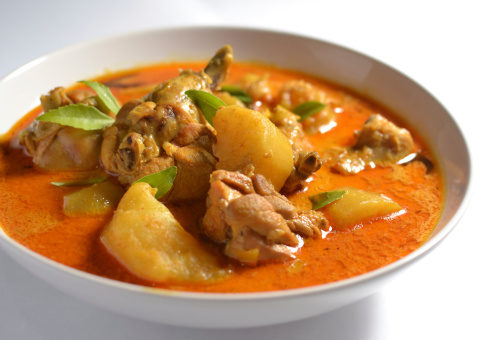Rice is an important part of meals in Thailand.
In Thailand the food is hot and spicy.
Curry is popular.
Thai people eat a lot of fish and vegetables.
Influences on cooking
Thailand was once called Siam. Originally, Siamese food reflected lifestyle of the people: people lived in houses built along canals or waterways, or on boats. Their food consisted of water plants and animals. Cooking methods were traditionally stewing, baking or grilling.
Thai food today is a blend of centuries old Asian and western influences.
Chinese influences added stir frying and deep frying to traditional cooking methods.
Stir-frying is a quick way of cooking : this dish is seafood with vegetables. It will be eaten with rice. ©Getty Images
From the 17th Century onwards, Portuguese, Dutch, French and Japanese explorers visited Thailand, or Siam as it was then, and also made an influence on cooking.
Chillies were introduced to Thai cooking by Portuguese missionaries in the late 17th century. The missionaries had taken a liking to them while working in South America.
Developing Thai food of today
The Thais adapted what they learned from others to their own fresh ingredients. They used coconut oil and coconut milk, lemongrass and galangal in place of the stronger fats and herbs of the introduced foods. In this way, they gradually changed these introduced foods and cooking methods to become their own particular style.
Eating a Thai meal
Generally, each diner has their own bowl of steamed rice, and the other dishes are shared. Two diners will have three dishes, three diners will have four, and so on. The dishes will generally balanced between spicy and bland. Soups are part of the meal, not served separately. It is not polite to put all food on your plate in one go. You just take a spoonful at a time. Thai food is eaten with a spoon and fork or chopsticks. The fork must never go into the mouth, but is used to break up food and push it onto the spoon. The spoon takes food to the mouth.
Thai desserts are quite sweet and often include fruit. ©Getty Images
A typical Thai meal
Thai breakfast dishes
Breakfast dishes include choices such as rice porridge with pork; egg omelette; chicken and rice.
Thai lunch and dinner dishes
Lunch and dinner dishes include egg noodle soup with pork and vegetables, green curry with beef, steamed squid (octopus) with lemon and chilli.
Dishes are about the same for both meals but lunch usually has one dish while at dinner it is normal to have three or four dishes to share. A typical balanced dinner meal might consist of a soup, a steamed dish, a fried dish, a hot salad and a variety of dipping sauces. This would be followed by a very sweet dessert, and/or fresh fruits such as mango, durian, jackfruit, papaya or melon.
Some Herbs and Seasonings Used in Thai Cooking
Lemongrass is used in curries and soups
Garlic
Garlic is one of the main ingredients in all Thai foods. It is used in curry pastes and in stir fries. Pickled garlic is eaten with spicy dishes.
Shallots
Shallots, a member of the onion family, are used in most Thai dishes, as an ingredient in curry pastes, dips and salads.
Galangal (Siamese ginger)
Galangal (Siamese ginger) is always used in curry pastes and sour and hot soups. Ginger is used in stir fried dishes or pickled and eaten with spicy food.
Lemongrass is used in curries and soups ©Getty Images
Lemongrass
Lemongrass is one of the most commonly used herbs and the one that gives Thai food its distinctive flavour. It is used in curry pastes and sour and hot soups.
Kaffir lime
The fruit and the leaves of kaffir lime are used.
Basil
There are 3 kinds of basil used in Thai food and each is used with different kinds of food.
Chillies
There are red and green chillies ©Getty
There are red and green chillies. There are many kinds of chillies grown in Thailand. The small red chillies are the hottest and are used in curries and sauces.
Coriander
The leaves and stalk, the roots, and the seeds of coriander are each used in different kinds of food because each part of the plant has its own unique flavour.
Fish sauce
Fish sauce is the main seasoning in Thai foods. It is called naam pla and is made from fermented anchovies.
Read the kidcyber page:
Palm Sugar
Palm Sugar is made from the flowers of the coconut tree. Many Thai dishes have a little sugar added to enhance the flavour.
Coconut milk
Coconut milk is an ingredient in both curries and desserts, and the coconut flesh (or meat) is a common ingredient also.
Curry paste
There are four different kinds of curries ©Getty
Curry paste is a combination of spices and herbs needed for flavouring a curry dish. There are different combinations according to the kind of curry being made.
There are four different curries:
Kaeng Ped, hot red curry;
Kaeng Keo Wan, green curry;
Kaeng Karee, yellow curry; and
Kaeng Masaman, a Thai-Indian curry.






